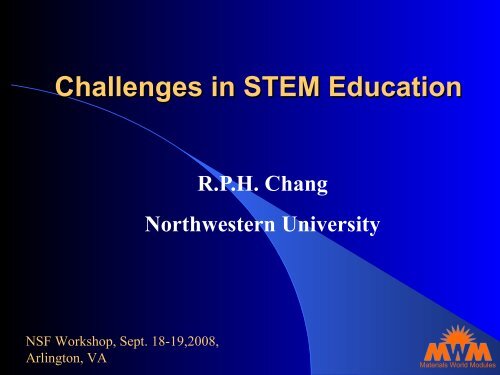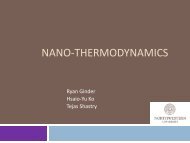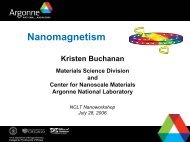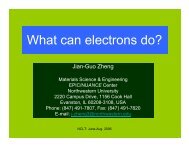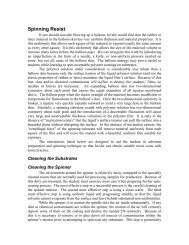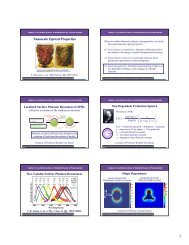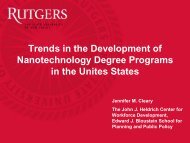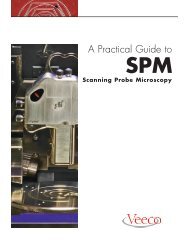Challenges in STEM Education - Materials World Modules
Challenges in STEM Education - Materials World Modules
Challenges in STEM Education - Materials World Modules
You also want an ePaper? Increase the reach of your titles
YUMPU automatically turns print PDFs into web optimized ePapers that Google loves.
<strong>Challenges</strong> <strong>in</strong> <strong>STEM</strong> <strong>Education</strong><br />
R.P.H. Chang<br />
Northwestern University<br />
NSF Workshop, Sept. 18-19,2008,<br />
Arl<strong>in</strong>gton, VA<br />
<strong>Materials</strong> <strong>World</strong> <strong>Modules</strong>
Outl<strong>in</strong>e of the presentation<br />
What is be<strong>in</strong>g projected 30 years from now?<br />
What are some of challenges <strong>in</strong> <strong>STEM</strong> education?<br />
What is <strong>Materials</strong> <strong>World</strong> <strong>Modules</strong> program do<strong>in</strong>g?<br />
The need for <strong>in</strong>tegration!<br />
<strong>Materials</strong> <strong>World</strong> <strong>Modules</strong>
30 years from now<br />
Oil production will peak<br />
Consequences of Global warm<strong>in</strong>g<br />
Global economic impact/Competition for natural<br />
resources<br />
Change <strong>in</strong> the US demographics<br />
Others???<br />
<strong>Materials</strong> <strong>World</strong> <strong>Modules</strong>
<strong>Challenges</strong> for U.S. <strong>in</strong> the 21 st<br />
• Educat<strong>in</strong>g our young people<br />
<strong>in</strong> the context of build<strong>in</strong>g<br />
knowledge-<strong>in</strong>tensive<br />
economies<br />
• Cont<strong>in</strong>ued global<br />
achievement gap between<br />
U.S. students—even our top<br />
perform<strong>in</strong>g students—and<br />
their <strong>in</strong>ternational peers<br />
Century<br />
Science and Eng<strong>in</strong>eer<strong>in</strong>g Indicators 2006<br />
<strong>Materials</strong> <strong>World</strong> <strong>Modules</strong>
Basic <strong>Challenges</strong> <strong>in</strong> K-12 <strong>STEM</strong><br />
<strong>Education</strong><br />
The need to produce a globally literate citizenry is critical<br />
to the nation's cont<strong>in</strong>ued success <strong>in</strong> the global economy<br />
– Human capital is key to cont<strong>in</strong>u<strong>in</strong>g S&T and S&E<br />
developments<br />
The need for secondary <strong>in</strong>stitutions to adapt to a world<br />
altered by technology, chang<strong>in</strong>g demographics and<br />
globalization<br />
– Several national studies confirm the <strong>in</strong>sufficient preparation of<br />
high school graduates for either college-level work or the<br />
chang<strong>in</strong>g needs of the workforce.<br />
– Low proficiency performance level, only 1/3 of 4 th and 8 th<br />
grade, and even fewer 12 th grade students, reached the proficient<br />
level for their grades<br />
<strong>Materials</strong> <strong>World</strong> <strong>Modules</strong>
Fund<strong>in</strong>g <strong>Challenges</strong> <strong>in</strong> K-12 <strong>STEM</strong><br />
<strong>Education</strong><br />
Spend<strong>in</strong>g <strong>in</strong>creases have not corresponded to <strong>in</strong>crease <strong>in</strong><br />
high school achievement rates<br />
1. US spend<strong>in</strong>g at all-time high –<br />
49% <strong>in</strong>crease over past 20 years<br />
2. S<strong>in</strong>ce 1985, real federal spend<strong>in</strong>g<br />
on K-12 education has <strong>in</strong>creased<br />
by 138%<br />
3. Only 17 percent of seniors are<br />
considered proficient <strong>in</strong> mathematics<br />
4. Only 36 percent are proficient <strong>in</strong> read<strong>in</strong>g<br />
<strong>Materials</strong> <strong>World</strong> <strong>Modules</strong>
Teacher <strong>Challenges</strong> <strong>in</strong> K-12 <strong>STEM</strong><br />
<strong>Education</strong><br />
A paucity of teachers who have the necessary knowledge<br />
and skills to effectively teach these subjects<br />
– Nationally, <strong>in</strong> academic year 2002—between 17-28% of<br />
public high school science and math teachers lack full<br />
certification<br />
– In academic year 1999, between 23-29% of middle and high<br />
school science and math teachers did not have a college major<br />
or m<strong>in</strong>or <strong>in</strong> their teach<strong>in</strong>g field<br />
Inadequate teacher compensation and professional<br />
development to attract, prepare and reta<strong>in</strong> high-quality<br />
teachers<br />
Compartmentalized subjects taught by teachers isolated<br />
with<strong>in</strong> and across departments<br />
<strong>Materials</strong> <strong>World</strong> <strong>Modules</strong>
Student <strong>Challenges</strong> <strong>in</strong> K-12 <strong>STEM</strong><br />
<strong>Education</strong><br />
Students generally lack motivation and have low self<br />
confidence <strong>in</strong> learn<strong>in</strong>g <strong>STEM</strong> subjects<br />
Persistent achievement gaps <strong>in</strong> science and math among<br />
many student subgroups<br />
– Disparities start<strong>in</strong>g as early as k<strong>in</strong>dergarten, cont<strong>in</strong>ue across<br />
grades, and widen<strong>in</strong>g over time<br />
– Substantial performance gaps exists between racial/ethnic<br />
groups<br />
– Sex differences were small but favored males <strong>in</strong> most cases<br />
Sweep<strong>in</strong>g demographic changes will exacerbate the gaps<br />
– Racial and ethnic m<strong>in</strong>orities will comprise the majority of the<br />
nation’s population by 2042<br />
<strong>Materials</strong> <strong>World</strong> <strong>Modules</strong>
The Demand for a 21 th Century<br />
<strong>Education</strong> and Skills<br />
“The best employers the world over will be look<strong>in</strong>g for the<br />
most competent, most creative, and most <strong>in</strong>novative people<br />
on the face of the earth and will be will<strong>in</strong>g to pay them top<br />
dollar for their services.<br />
This will be true not just for the top professionals and<br />
managers, but up and down the length and breadth of the<br />
workforce.<br />
Those countries that produce the most important new<br />
products and services can capture a premium <strong>in</strong> world<br />
markets that will enable them to pay high wages to their<br />
citizens.” --The New Commission on the Skills of the American Workforce,<br />
National Center on <strong>Education</strong> and the Economy, 2007<br />
<strong>Materials</strong> <strong>World</strong> <strong>Modules</strong>
21 st Century Curriculum and Instruction<br />
Curriculum must go beyond content knowledge to <strong>in</strong>clude a<br />
strong emphasis on 21 st century skills development<br />
Use an <strong>in</strong>tegrative approach to curriculum—one that unites<br />
core academic subject matter, <strong>in</strong>terdiscipl<strong>in</strong>ary themes, and<br />
essential skills<br />
– Solve open-ended problems (design-based)<br />
– Promote cooperative learn<strong>in</strong>g<br />
– Use real-world contexts<br />
– Take advantage of advanced technologies<br />
– Adopt effective assessment strategies<br />
Provide a pathway for learn<strong>in</strong>g to help students succeed <strong>in</strong><br />
college, work and life<br />
--Adapted from Partnership for 21 st Century Skills, 2007<br />
<strong>Materials</strong> <strong>World</strong> <strong>Modules</strong>
Components of a 21 st Century<br />
<strong>STEM</strong> Curriculum and Instruction<br />
Th<strong>in</strong>k<strong>in</strong>g critically and mak<strong>in</strong>g judgments<br />
Solv<strong>in</strong>g complex, multidiscipl<strong>in</strong>ary, open-ended<br />
problems<br />
Creative and entrepreneurial th<strong>in</strong>k<strong>in</strong>g<br />
Communicat<strong>in</strong>g and collaborat<strong>in</strong>g<br />
Mak<strong>in</strong>g <strong>in</strong>novative use of knowledge, <strong>in</strong>formation and<br />
opportunities<br />
Tak<strong>in</strong>g charge of civic responsibilities<br />
<strong>Materials</strong> <strong>World</strong> <strong>Modules</strong>
MWM—a Highly Effective <strong>STEM</strong> Curriculum<br />
Nationwide study show student acquisition of many of<br />
the characteristics associated with learn<strong>in</strong>g :<br />
Exceptional ga<strong>in</strong> <strong>in</strong> new content knowledge among all<br />
student subgroups; female is slightly favored<br />
In depth learn<strong>in</strong>g of <strong>STEM</strong> concepts<br />
Critical th<strong>in</strong>k<strong>in</strong>g and problem solv<strong>in</strong>g skills<br />
Improved teamwork; shar<strong>in</strong>g responsibilities<br />
Overcom<strong>in</strong>g a fear of failure<br />
Improved student self-esteem <strong>in</strong> science learn<strong>in</strong>g<br />
<strong>Materials</strong> <strong>World</strong> <strong>Modules</strong>
•Understand concepts as opposed to memorize them<br />
•Will<strong>in</strong>g to take risks <strong>in</strong> order to advance an idea<br />
•Will<strong>in</strong>g to pursue a new direction; look for a “best solution”<br />
•Apply learned content knowledge <strong>in</strong> a new context<br />
•Make decisions based on criteria and data<br />
•Develop the skills of <strong>in</strong>novation<br />
•Th<strong>in</strong>k <strong>in</strong> unconstra<strong>in</strong>ed ways or "outside the box"<br />
<strong>Materials</strong> <strong>World</strong> <strong>Modules</strong>
<strong>Materials</strong><br />
<strong>World</strong><strong>Modules</strong>odules<br />
An NSF Inquiry & Design based<br />
(<strong>STEM</strong>) <strong>Education</strong> Program<br />
R.P.H. Chang<br />
Northwestern University<br />
<strong>Materials</strong> <strong>World</strong> <strong>Modules</strong>
<strong>Materials</strong> <strong>World</strong> <strong>Modules</strong> Program<br />
Connects Science and Math Curricula<br />
to the Real <strong>World</strong><br />
Traditional<br />
Science, Math,<br />
and Technology<br />
Curriculum<br />
MWM<br />
Real-<strong>World</strong><br />
Applications<br />
<strong>Materials</strong> <strong>World</strong> <strong>Modules</strong>
<strong>Materials</strong> <strong>World</strong> <strong>Modules</strong><br />
Published <strong>Modules</strong><br />
<br />
<br />
<br />
Composites<br />
Concrete<br />
Sports Mat’ls<br />
<br />
<br />
<br />
Biodeg. Mat’ls<br />
Biosensors<br />
Food Pkg<strong>in</strong>g Mat’ls<br />
Ceramics<br />
Polymers<br />
Smart Sensors<br />
Com<strong>in</strong>g Soon!<br />
Environ. Catalysis<br />
Nanotechnology Module<br />
<strong>Materials</strong> <strong>World</strong> <strong>Modules</strong>
Creat<strong>in</strong>g Interdisciplanary &<br />
Globally & Socially Relevant <strong>Modules</strong><br />
Energy<br />
History<br />
Health<br />
Culture<br />
Environment<br />
Language/<br />
Arts<br />
Transportation<br />
Nano<br />
technology<br />
Physical<br />
Sciences<br />
Social<br />
Science<br />
<strong>Materials</strong> <strong>World</strong> <strong>Modules</strong>
MWM Promotes Integrated Learn<strong>in</strong>g<br />
<strong>Materials</strong> <strong>World</strong> <strong>Modules</strong> (MWM )<br />
provides <strong>in</strong>terdiscipl<strong>in</strong>ary science<br />
teach<strong>in</strong>g.<br />
Technology<br />
Math<br />
MWM<br />
Biology<br />
MWM<br />
Chemistry<br />
Physics<br />
MWM provides an<br />
<strong>in</strong>tegrated science and math<br />
learn<strong>in</strong>g experience.<br />
<strong>Materials</strong> <strong>World</strong> <strong>Modules</strong>
Development of<br />
<strong>Materials</strong> <strong>World</strong> <strong>Modules</strong><br />
Secondary<br />
School Science,<br />
Math, and<br />
Technology<br />
Teachers<br />
Northwestern<br />
University<br />
Scientists &<br />
Researchers<br />
Northwestern<br />
University<br />
<strong>Education</strong>al<br />
Researchers<br />
Professional<br />
Editors, Designers,<br />
Graphic Artists, etc.<br />
<strong>Materials</strong> <strong>World</strong> <strong>Modules</strong>
MWM’s Model:<br />
Inquiry and Design<br />
Students complete a<br />
series of hands-on,<br />
<strong>in</strong>quiry-based activities<br />
Each module culm<strong>in</strong>ates<br />
<strong>in</strong> design challenges<br />
Students simulate the<br />
work of scientists<br />
(through activities that<br />
foster <strong>in</strong>quiry) and<br />
eng<strong>in</strong>eers (through<br />
design)<br />
Inquiry cycle<br />
Identify a question.<br />
Propose an explanation.<br />
Create and perform an<br />
experiment to test the<br />
hypothesis. Based on<br />
results, ref<strong>in</strong>e the<br />
explanation.<br />
Goal: an explanation<br />
Design cycle<br />
Identify a problem.<br />
Propose, build, and<br />
test a solution to the<br />
problem. Redesign,<br />
Based on results, to<br />
improve the<br />
solution.<br />
a functional product<br />
<strong>Materials</strong> <strong>World</strong> <strong>Modules</strong>
Ma<strong>in</strong> Components of MWM<br />
Piques student <strong>in</strong>terest <strong>in</strong> the topic<br />
Provides students with background and<br />
concepts central to the topic<br />
The Hook<br />
Stag<strong>in</strong>g Activities<br />
<strong>Challenges</strong> students to apply what they have<br />
learned to create a functional design<br />
Revisits steps <strong>in</strong> the design process to make<br />
adjustments to improve the <strong>in</strong>itial designs<br />
Design Challenge<br />
Redesign<br />
<strong>Materials</strong> <strong>World</strong> <strong>Modules</strong>
MWM Helps To Meet Standards<br />
MWM L<strong>in</strong>ks to the follow<strong>in</strong>g National Science <strong>Education</strong> Standards:<br />
<br />
<br />
<br />
<br />
<br />
<br />
<br />
Unify<strong>in</strong>g concepts and<br />
processes <strong>in</strong> science<br />
Science as <strong>in</strong>quiry<br />
Physical science<br />
Life science<br />
Earth and space science<br />
Science and technology<br />
Science <strong>in</strong> personal and<br />
social perspective<br />
<strong>Materials</strong> <strong>World</strong> <strong>Modules</strong>
AAAS Benchmark Standards<br />
Sports <strong>Materials</strong> Module<br />
Grades 9-12<br />
1. The Nature of Science<br />
Module Alignment<br />
Alignment to the National Standards<br />
Alignment to the National Standards<br />
•The American Association for the<br />
Advancement of Sciences Benchmarks<br />
•National Science <strong>Education</strong> Standards<br />
A. The Scientific world view <br />
B. Scientific <strong>in</strong>quiry <br />
C. The Scientific enterprise <br />
NSES Standards<br />
Sports Material Module<br />
Grades 9-12<br />
Module Alignment<br />
2. The Nature of Mathematics<br />
A. Patterns and relationships<br />
B. Mathematics, science, and technology <br />
C. Mathematical <strong>in</strong>quiry<br />
3. The Nature of Technology<br />
A. Technology and science <br />
B. Design and systems <br />
C. Issues <strong>in</strong> technology<br />
4. The Physical Sett<strong>in</strong>g<br />
A. The universe<br />
B. The earth<br />
C. Processes that shape the earth<br />
D. Structure of matter <br />
E. Energy transformations <br />
F. Motion <br />
G. Forces of nature<br />
Unify<strong>in</strong>g Concepts and Processes<br />
1. Systems, order, and organization<br />
2. Evidence, models, and explanation <br />
3. Constancy, change, and measurement <br />
4. Evolution and equilibrium<br />
5. Form and function <br />
A. Science as Inquiry<br />
1. Ability to do scientific <strong>in</strong>quiry <br />
2. Understand<strong>in</strong>g scientific <strong>in</strong>quiry <br />
B. Physical Science<br />
1. Structure of atoms<br />
2. Structure and properties of matter <br />
3. Chemical reactions<br />
4. Motions and forces <br />
5. Conservation of energy <br />
6. Interactions of energy and matter <br />
<strong>Materials</strong> <strong>World</strong> <strong>Modules</strong>
Sports <strong>Materials</strong> Module<br />
Alignment with NJ & CA State Standards<br />
New Jersey—Physical Science / Physics / B. Energy Transformations<br />
• Expla<strong>in</strong> that while energy can be transformed from one form to another, the total energy of a closed system is<br />
constant.<br />
• Recognize that whenever mechanical energy is transformed, some heat is dissipated and is therefore<br />
unavailable for use.<br />
• Expla<strong>in</strong> the nature of electromagnetic radiation and compare the components of the electromagnetic spectrum<br />
from radio waves to gamma rays.<br />
• Expla<strong>in</strong> how the various forms of energy (heat, electricity, sound, light) move through materials and identify the<br />
factors that affect that movement.<br />
California—Physics / Conservation of Energy and Momentum<br />
2. The laws of conservation of energy and momentum provide a way to predict and<br />
describe the movement of objects. As a basis for understand<strong>in</strong>g this concept:<br />
• Students know how to calculate k<strong>in</strong>etic energy by us<strong>in</strong>g the formula E=(1/2)mv 2 .<br />
• Students know how to calculate changes <strong>in</strong> gravitational potential energy near Earth by us<strong>in</strong>g the formula<br />
(change <strong>in</strong> potential energy) =mgh (h is the change <strong>in</strong> the elevation).<br />
• Students know how to solve problems <strong>in</strong>volv<strong>in</strong>g conservation of energy <strong>in</strong> simple systems, such as fall<strong>in</strong>g<br />
objects.<br />
• Students know how to calculate momentum as the product mv.<br />
• Students know momentum is a separately conserved quantity different from energy.<br />
• Students know an unbalanced force on an object produces a change <strong>in</strong> its momentum.<br />
• Students know how to solve problems <strong>in</strong>volv<strong>in</strong>g elastic and <strong>in</strong>elastic collisions <strong>in</strong> one dimension by us<strong>in</strong>g the<br />
pr<strong>in</strong>ciples of conservation of momentum and energy.<br />
• * Students know how to solve problems <strong>in</strong>volv<strong>in</strong>g conservation of energy <strong>in</strong> simple systems with various<br />
sources of potential energy, such as capacitors and spr<strong>in</strong>gs.<br />
<strong>Materials</strong> <strong>World</strong> <strong>Modules</strong>
MWM: A Total <strong>Education</strong>al Program<br />
Network<br />
of<br />
Teachers<br />
Web Support<br />
for students<br />
& teachers<br />
11 Hands-on,<br />
<strong>in</strong>quiry-based<br />
<strong>Modules</strong><br />
Module<br />
Booklets &<br />
Activity Kits<br />
Tra<strong>in</strong><strong>in</strong>g/<br />
Workshops<br />
for Teachers<br />
<strong>Materials</strong> <strong>World</strong> <strong>Modules</strong>
MWM Activity Kits<br />
<br />
<br />
<br />
Starter and refill kits are available<br />
for each module<br />
Kits conta<strong>in</strong> enough materials<br />
for a class of 24 - 32 students<br />
Kits range <strong>in</strong> price<br />
depend<strong>in</strong>g upon the<br />
materials they conta<strong>in</strong><br />
<strong>Materials</strong> <strong>World</strong> <strong>Modules</strong>
Workshops/Teacher Tra<strong>in</strong><strong>in</strong>g<br />
Dur<strong>in</strong>g workshops, module developers and master teachers of<br />
MWM work with new teachers to help them:<br />
<br />
<br />
<br />
<br />
Learn about MWM’s philosophy of<br />
<strong>in</strong>quiry through design<br />
Experiment with module activities<br />
and design challenges<br />
Discuss practical and theoretical<br />
issues regard<strong>in</strong>g the<br />
implementation of MWM <strong>in</strong>to the<br />
classroom<br />
Establish a network of MWM<br />
resources with<strong>in</strong> their school and<br />
area, as well as with NU<br />
<strong>Materials</strong> <strong>World</strong> <strong>Modules</strong>
Evaluations &<br />
Assessments Improve<br />
MWM<br />
<strong>Materials</strong> <strong>World</strong> <strong>Modules</strong>
MWM Produces Results<br />
Field-test results <strong>in</strong>dicate that with MWM:<br />
Girls acquire more science knowledge than boys<br />
Students of all races and socioeconomic status<br />
excel<br />
Teachers of all experience levels can participate<br />
Curriculum meets National Science <strong>Education</strong><br />
Standards<br />
Positive Student Ga<strong>in</strong>s<br />
Effect Size<br />
(Standardized Mean Ga<strong>in</strong> <strong>in</strong><br />
standard deviation units)<br />
3<br />
2<br />
1<br />
0<br />
Results for BOYS and GIRLS were avg. over all 5<br />
field test modules<br />
2.59 ± .58<br />
3.04 ± .63<br />
0.8<br />
Pre-test<br />
Post-test<br />
• •<br />
• • • •<br />
• • • •• • •<br />
• • •<br />
• • •<br />
• • •<br />
•<br />
•<br />
•<br />
•<br />
•<br />
•<br />
•• • •<br />
48 states across the US<br />
•<br />
• •<br />
• •<br />
•<br />
•<br />
• •<br />
•<br />
• • • •<br />
•<br />
• •<br />
•<br />
• •<br />
• •<br />
•<br />
~ 40,000 students<br />
• •<br />
• •<br />
• •<br />
• • •<br />
• •<br />
• •<br />
• •<br />
•<br />
•<br />
•<br />
•<br />
•<br />
• • • • •<br />
• •<br />
• • • •<br />
• • •<br />
•<br />
•<br />
• •<br />
•<br />
• •<br />
•<br />
•<br />
•<br />
•<br />
•<br />
• • • •<br />
•<br />
•<br />
• •<br />
•<br />
•<br />
•<br />
• •<br />
•<br />
•<br />
• •<br />
• •<br />
• •<br />
•<br />
•<br />
•<br />
•<br />
Boys<br />
Girls<br />
Ref.*<br />
* Traditionally, 0.8 is considered a large effect.<br />
<strong>Materials</strong> <strong>World</strong> <strong>Modules</strong>
<strong>Materials</strong> <strong>World</strong> <strong>Modules</strong> - Spanish<br />
Expands to Chihuahua, Mexico and Puerto Rico<br />
The <strong>Materials</strong> <strong>World</strong> <strong>Modules</strong> Program (MWM) has recently<br />
translated five of its modules <strong>in</strong>to Spanish. In 2005, the Centro<br />
De Investigacio en Materiales Avanzados and the Department of<br />
<strong>Education</strong> & Culture for the state of Chihuahua provided support<br />
to tra<strong>in</strong> 50 high school teachers <strong>in</strong> Chihuahua, Mexico.<br />
S<strong>in</strong>ce the 2005 Workshop, MWM has been used by 35 schools,<br />
<strong>in</strong>clud<strong>in</strong>g 120 teachers, 1200 students, and 7 cities and towns,<br />
<strong>in</strong> the state of Chihuahua. Results <strong>in</strong>dicate that these modules<br />
helped to improve science achievement with these students.<br />
BLUE: Before<br />
PURPLE: After<br />
In February, 2007, MWM worked with professors at the<br />
University of Puerto Rico to tra<strong>in</strong> lead <strong>STEM</strong><br />
teachers <strong>in</strong> Puerto Rico on four modules, which will be<br />
dissem<strong>in</strong>ated to schools around the Island.<br />
<strong>Materials</strong> <strong>World</strong> <strong>Modules</strong>
Why Integration?<br />
Tra<strong>in</strong> more scientists and eng<strong>in</strong>eers who are highlyskilled<br />
and globally-engaged<br />
Increase science literacy across all sectors of society<br />
Build capacity to address global challenges <strong>in</strong> energy,<br />
environment, health, communications, and security.<br />
Create relevance for students - strong connections<br />
between science concepts and their real-world<br />
applications.<br />
<strong>Materials</strong> <strong>World</strong> <strong>Modules</strong>
Rationale<br />
Why <strong>Materials</strong> Science?<br />
Why <strong>Materials</strong> <strong>Education</strong>?<br />
<br />
<strong>Materials</strong> and their<br />
properties are the basis for<br />
all technology, <strong>in</strong>clud<strong>in</strong>g<br />
emerg<strong>in</strong>g areas such as bioand<br />
nano- technologies.<br />
<br />
<br />
Excellent Integrator<br />
Fosters creative problemsolv<strong>in</strong>g<br />
<br />
<br />
New materials are vital to:<br />
– Industrial development<br />
– Energy efficiency<br />
– Environmental stewardship<br />
– Medic<strong>in</strong>e<br />
– Information systems<br />
– Civil <strong>in</strong>frastructures<br />
– Global security, etc.<br />
MSE comb<strong>in</strong>es the best of<br />
science and eng<strong>in</strong>eer<strong>in</strong>g<br />
<br />
<br />
<br />
<br />
Improves science literacy<br />
for all citizens<br />
Creates relevance for<br />
students – i.e. strong<br />
connections to everyday life<br />
Workforce development<br />
for all sectors<br />
Preparation for global<br />
challenges<br />
<strong>Materials</strong> <strong>World</strong> <strong>Modules</strong>
Paradigm for Integration<br />
Vertical (Across Grade Levels)<br />
Systems (Across Sectors)<br />
Government<br />
R&D<br />
Cycle<br />
Industry<br />
Academia<br />
Global (Across Regions)<br />
Horizontal (Across Discipl<strong>in</strong>es)<br />
<strong>Materials</strong> <strong>World</strong> <strong>Modules</strong>
www.materialsworldmodules.org<br />
<strong>Materials</strong> <strong>World</strong> <strong>Modules</strong>


